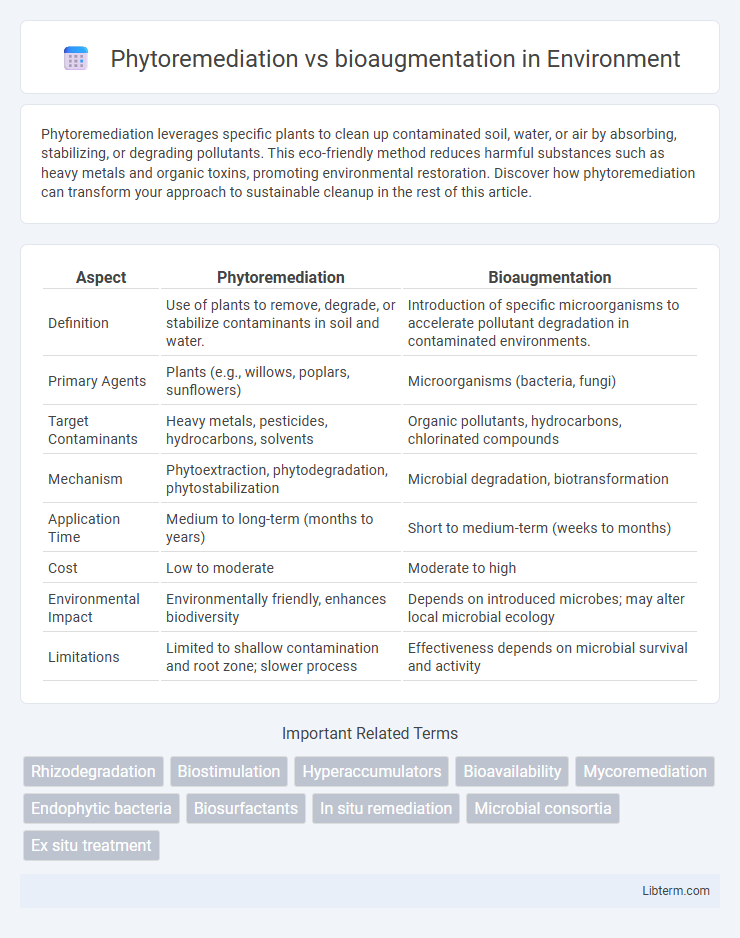Phytoremediation leverages specific plants to clean up contaminated soil, water, or air by absorbing, stabilizing, or degrading pollutants. This eco-friendly method reduces harmful substances such as heavy metals and organic toxins, promoting environmental restoration. Discover how phytoremediation can transform your approach to sustainable cleanup in the rest of this article.
Table of Comparison
| Aspect | Phytoremediation | Bioaugmentation |
|---|---|---|
| Definition | Use of plants to remove, degrade, or stabilize contaminants in soil and water. | Introduction of specific microorganisms to accelerate pollutant degradation in contaminated environments. |
| Primary Agents | Plants (e.g., willows, poplars, sunflowers) | Microorganisms (bacteria, fungi) |
| Target Contaminants | Heavy metals, pesticides, hydrocarbons, solvents | Organic pollutants, hydrocarbons, chlorinated compounds |
| Mechanism | Phytoextraction, phytodegradation, phytostabilization | Microbial degradation, biotransformation |
| Application Time | Medium to long-term (months to years) | Short to medium-term (weeks to months) |
| Cost | Low to moderate | Moderate to high |
| Environmental Impact | Environmentally friendly, enhances biodiversity | Depends on introduced microbes; may alter local microbial ecology |
| Limitations | Limited to shallow contamination and root zone; slower process | Effectiveness depends on microbial survival and activity |
Introduction to Phytoremediation and Bioaugmentation
Phytoremediation utilizes plants to absorb, degrade, or stabilize contaminants in soil and water, making it an eco-friendly and cost-effective approach for pollution cleanup. Bioaugmentation involves introducing specialized microorganisms to contaminated sites to enhance the natural biodegradation of pollutants, accelerating remediation processes. Both methods offer sustainable solutions, with phytoremediation leveraging plant biology and bioaugmentation relying on microbial activity for environmental restoration.
Defining Phytoremediation: Principles and Mechanisms
Phytoremediation is an eco-friendly remediation technology that uses plants to remove, degrade, or stabilize contaminants in soil, water, and air by mechanisms such as phytoextraction, phytodegradation, phytostabilization, and rhizodegradation. The process leverages plant root systems and associated microbial activity to bioaccumulate heavy metals, metabolize organic pollutants, and immobilize toxic substances, making it particularly effective for heavy metal and organic compound contamination. Unlike bioaugmentation, which introduces specialized microbial strains to enhance degradation, phytoremediation relies on natural plant-microbe interactions for contaminant removal.
Understanding Bioaugmentation: Key Concepts and Processes
Bioaugmentation involves the deliberate introduction of specialized microbial strains into contaminated environments to accelerate the degradation of pollutants, enhancing natural bioremediation processes. This technique relies on selecting microbes with specific metabolic capabilities to target complex or recalcitrant contaminants that native microorganisms struggle to break down. Effective bioaugmentation demands careful assessment of environmental conditions such as pH, temperature, and nutrient availability to ensure microbial survival and activity for optimal contaminant removal.
Comparative Analysis: Efficiency in Pollutant Removal
Phytoremediation utilizes plants to absorb, degrade, or stabilize pollutants, showing high efficiency in removing heavy metals and organic contaminants from soil and water through root uptake and rhizosphere interactions. Bioaugmentation involves introducing specialized microbial strains to accelerate the breakdown of pollutants, often proving faster and more effective for complex organic compounds like petroleum hydrocarbons and chlorinated solvents. Comparative studies reveal phytoremediation excels in long-term stabilization and eco-friendly restoration, while bioaugmentation offers rapid degradation rates but may require precise environmental control for microbial survival and activity.
Types of Contaminants Targeted by Each Method
Phytoremediation primarily targets organic pollutants such as petroleum hydrocarbons, pesticides, and heavy metals like lead and cadmium through plant uptake and stabilization processes. Bioaugmentation focuses on enhancing microbial populations to degrade specific contaminants including chlorinated solvents, polycyclic aromatic hydrocarbons (PAHs), and nitrogenous compounds in soil and groundwater. Both methods complement each other by addressing a wide range of contaminants through biological mechanisms tailored to different pollution profiles.
Advantages and Limitations of Phytoremediation
Phytoremediation offers a cost-effective and environmentally friendly solution for removing heavy metals, organic pollutants, and contaminants through plant uptake, stabilization, and degradation, making it ideal for large-scale soil and water remediation. Its limited effectiveness in treating highly contaminated sites, slow remediation rates, and dependence on plant growth conditions such as climate, soil type, and pollutant bioavailability restrict its applicability. Unlike bioaugmentation, which involves introducing specialized microorganisms to accelerate biodegradation, phytoremediation leverages natural plant processes but lacks the rapid contaminant breakdown capacity seen in microbial treatments.
Pros and Cons of Bioaugmentation
Bioaugmentation enhances soil and water treatment by introducing specialized microbial strains to degrade contaminants more rapidly than natural microbiota, accelerating pollutant breakdown and restoring ecosystems efficiently. However, its effectiveness can be limited by environmental factors such as pH, temperature, and nutrient availability, which may inhibit microbial survival and activity. Potential risks include disruption of native microbial communities and incomplete degradation leading to toxic byproducts.
Applications in Real-World Environmental Remediation
Phytoremediation employs plants such as willows and poplars to extract heavy metals and organic pollutants from contaminated soils, proving effective in sites impacted by industrial waste and mining activities. Bioaugmentation involves introducing specialized microbial strains like Pseudomonas and Bacillus species to accelerate the degradation of hydrocarbons in oil spill-affected marine and terrestrial environments. Both techniques offer sustainable, cost-effective solutions for restoring soil and water quality, with phytoremediation best suited for large-scale land restoration and bioaugmentation excelling in rapid contaminant breakdown in localized hotspots.
Environmental Impact and Sustainability Considerations
Phytoremediation utilizes plants to absorb, degrade, or stabilize contaminants from soil and water, offering a low-energy, carbon-sequestering approach that enhances biodiversity and restores ecosystems naturally. Bioaugmentation involves the introduction of specialized microbial strains to accelerate pollutant degradation, providing targeted remediation but potentially disrupting native microbial communities and requiring careful management of inoculants. Sustainable environmental remediation prioritizes methods like phytoremediation for long-term ecosystem health and minimal chemical inputs, while bioaugmentation's effectiveness depends on maintaining microbial balance and ensuring no harmful byproducts persist post-treatment.
Future Trends and Innovations in Remediation Technologies
Phytoremediation leverages plant species to absorb, degrade, or immobilize contaminants, showing promise in sustainable and cost-effective soil and water cleanup. Bioaugmentation introduces specialized microbial strains to accelerate biodegradation, enhancing pollutant breakdown rates, especially in complex or recalcitrant contaminations. Future trends emphasize integrating genetic engineering, microbial consortia optimization, and nanotechnology to enhance remediation efficiency, targeting persistent organic pollutants and heavy metals with improved environmental compatibility.
Phytoremediation Infographic

 libterm.com
libterm.com